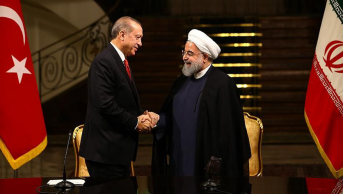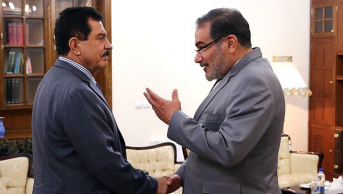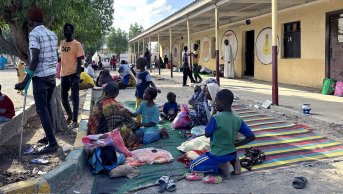Implications of Iran-Saudi Arabia Antagonism on Regional Issues
The controversy over Iranian nuclear program that has been one of the most important security concerns in Middle Eastern politics for over a decade has been resolved with a deal between P5+1 and Iran in July 2015. Thus, as President Hassan Rouhani stated, a new era has begun in Iranian foreign policy. Since then, the question over possible implications of the deal on Iran’s policy towards the Middle East has become one of the most debated issues. Nevertheless, despite some improvements in the regional politics after the deal, relations between Iran and Saudi Arabia remained tense. The tension between the two countries profoundly affects regional issues in the Middle East.
Iran’s Middle East Policy After the Nuclear Deal and Saudi Arabia
Soon after the nuclear deal has been concluded, the Iranian government initiated a new diplomatic attempt that aimed at improving its relations with the Middle Eastern countries. One of the architects of the deal, M. Javad Zarif, Foreign Minister of Iran, made two series of visits to the regional countries in order to elucidate the deal and Iranian foreign policy. In the first part of his regional tour, he visited Kuwait, Qatar and Iraq, and called ‘terrorism, violent extremism and sectarianism’ as the primary issues in the region, on which his government was ready to cooperate with the Persian Gulf countries. Moreover, he put forward the idea of a new collective forum for dialogue in the Persian Gulf region that would address regional issues in a comprehensive way. His call for regional countries actually aimed to address Saudi Arabia, the most influential country in the Persian Gulf. However, Iranian calls for regional dialogue and cooperation were not taken into account by Saudi Arabia. According to the Saudi officials, before anything else Iran should take some concrete steps in order to prove the so-called change in Iranian foreign policy. To them, Iran’s call for dialogue was meaningless because it has not altered its position towards Iraq, Syria, or Yemen. Furthermore, in his second tour to the regional countries, Zarif visited Lebanon and Syria, where he declared that Iran would maintain its support for the Assad administration. Likewise, although Iranian officials declared some diplomatic initiatives to solve the crisis, Tehran regime increased its military presence in Syria. Hence, although there has been a considerable change in tone in Iranian rhetoric towards the region, there has been no improvement on the ground.
Additionally, since the deal, the Western countries led by the United States have started to regard Iran as a possible partner in the solution of Middle Eastern issues. As a result of this change, Iran was invited for the first time to international talks on the Syrian conflict that was hold in Vienna on October 31, 2005, which was arranged by the US and Russian foreign ministers. Besides the participation of Iran, the participation of some regional countries including Saudi Arabia was one of the outstanding characteristics of the Vienna talks. It was an improvement, because Saudi Arabia had previously declined to join quadripartite dialogue meetings including Egypt, Iran, Saudi Arabia, and Turkey, which had been suggested by the then-Egyptian President Mohammad Morsi in September 2012, as a forum to negotiate the Syrian conflict. That is why, the Vienna talks that brought Iran and Saudi Arabia to the negotiation table increased hopes for regional cooperation for the solution of the Syrian conflict. However, the tension between Riyadh and Tehran that pursue controversial policies in Syria was evident at the Vienna talks as well. Iranian Foreign Minister Zarif blamed Saudi Arabia for supporting terrorism. Saudi Foreign Minister Adil al-Jubeyr claimed that Iran has been a part of the conflict in Syria and referred Iranian soldiers serving in Syria as the ‘occupying’ force. Later on, Deputy Foreign Minister of Iran, Hussein Amir Abdollahian, stated that Iran might quit the talks because of the ‘negative and unconstructive role’ of Saudi Arabia.
Iranian-Saudi Tension
As it has been evident at the Vienna talks, the tension and competition between Iran and Saudi Arabia is one of the leading reasons for the deepening of the regional conflicts and the failure of regional cooperation initiatives. It is known that Iran-Saudi Arabia relations have been troubled since 1979. Iranian policy to export its revolution, Saudi support to Saddam Hussain throughout the Iran-Iraq war, and political activities of Iranian pilgrims in Mecca adversely affected Tehran-Riyadh relations during the 1980s. In addition to rise of pragmatism in Iranian foreign policy in the 1990s, a common perception of threat perceived by Iran and Saudi Arabia coming from Iraq under Saddam contributed to rapprochement between Tehran and Riyadh. That rapprochement ended with the overthrown of Saddam Hussain in 2003. Moreover, the increasing power of pro-Iran Shiite movements in Baghdad shattered regional balance of power as well as Iran-Saudi relations. The uncompromising and radical foreign policy of Iran under President Mahmoud Ahmadinejad revived the tense relations between Tehran and Riyadh. The increasing tension between the two countries eventually turned into a number of proxy wars in the new conflicts that emerged after the Arab Spring. The two countries that have involved in a competition for influence in Lebanon for long years and in Iraq after the removal of Saddam, confronted each other over the Syrian conflict. Finally, the Saudi military intervention against the Houthis that seized power in Yemen sparked strong reactions on the Iranian side.
Besides the regional crisis and conflicts where the two countries confronted each other, two recent developments caused increase in tension in the Tehran-Riyadh relations. The first one was the death of more than 460 Iranians in the stampede happened on September 24, 2015 during the pilgrimage in Mecca. While the Iranian officials held the Saudi government responsible for the disaster, the Saudi government argued that the Iranian pilgrims who moved disorderly were responsible. During this disaster, news came up that the ex-Ambassador of Iran to Beirut, Gazanfar Ruknabadi, was among the wounded and he then disappeared. The Saudi government declared that Ruknabadi arrived Saudi Arabia in illegal ways; but Iran denied these allegations. Iranian officials consider it likely that Ruknabadi has been kidnapped.
Another development that increased tension between the two countries is the approval of death sentence issued for one of the prominent Shi’i clergy of Saudi Arabia, Shaykh Nimr by the Court of Appeal on October 25, 2015. Shaykh Nimr was arrested after being shot during the anti-government protests in 2012, and was sentenced to death in October 2014 on the charge of ‘inciting aggression among the sects and provoking the uprisings.’ Iranian Vice-Minister of Foreign Affairs, Amir Abollahian, stated that the death sentence issued for Shaykh Nimr was worrisome and said “The repercussion of the execution of Shaykh Nimr will be hard.” The battle of words between Iranian and Saudi officials has been going on intensely.
The recriminations between Iranian and Saudi officials and the tension between the two states negatively affect the unofficial meetings that aim at establishing dialogue among the parties. The Gulf countries, mainly Saudi Arabia, accuse Iran as being the chief responsible for the regional problems. According to this view, Iran tries to establish its own hegemony in the region and utilizes the Shi’ite minorities for its aim. Iran primarily dissociates the Shi’ite minorities from the societies they are living in and then intervenes by providing military and economic support to these groups. According to Iranians, however, the roots of the regional problems lie in a number of factors such as foreign/imperialist interventions, and anti-Iran and anti-Shi’i sectarian policies of some regional countries such as Saudi Arabia.
Despite mutual accusations between Iran and Saudi Arabia, regional conflicts and problems cannot be explained solely on the basis of competition and tension between these two states. Regional crises and conflicts feature complex, intermingled causes and specific dynamics. Nonetheless, Tehran-Riyadh competition caused the deepening of the breaking-points in these crises. Likewise, the tense relations of the two states disrupt the regional initiatives for solving the problems through diplomatic means.









